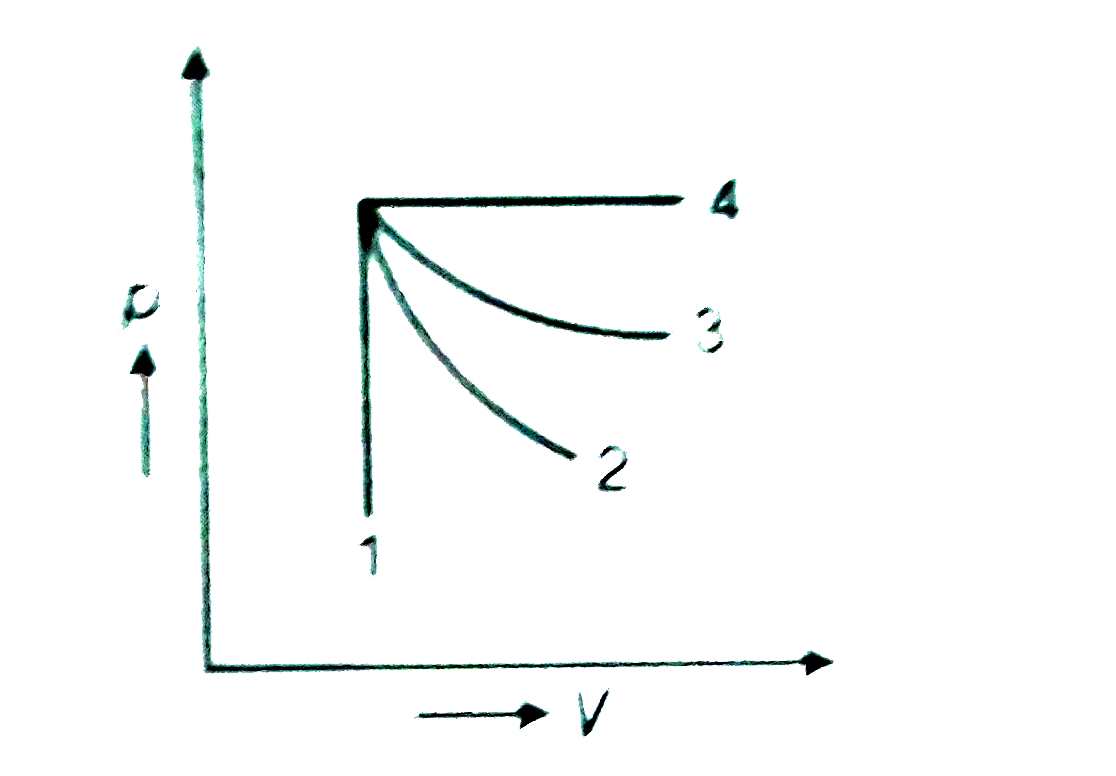An ideal gas undergoes four processes: isochoric, isobaric, isothermal and adiabatic. In which process is (ii) the work done zero?Solution in Bengali
Work done is zero when the volume remains constant. So the corresponding process is an isochoric process.
Topper's Solved these Questions
- BOOK - CHHAYA PUBLICATIONCHAPTER - FIRST AND SECOND LAW OF THERMODYNAMICSEXERCISE - Exercise - Multiple Choice Questions (Mark 1)31videos
FIRST AND SECOND LAW OF THERMODYNAMICS
- BOOK - CHHAYA PUBLICATIONCHAPTER - FIRST AND SECOND LAW OF THERMODYNAMICSEXERCISE - Exercise - Very Short Answer Type Questions (Mark 1)53videos
FIRST AND SECOND LAW OF THERMODYNAMICS
- BOOK - CHHAYA PUBLICATIONCHAPTER - FIRST AND SECOND LAW OF THERMODYNAMICSEXERCISE - Section Related Questions50videos
FIRST AND SECOND LAW OF THERMODYNAMICS
- BOOK - CHHAYA PUBLICATIONCHAPTER - EXPANSION OF SOLIDS AND LIQUIDSEXERCISE - CBSE SCANNER2videos
EXPANSION OF SOLIDS AND LIQUIDS
- BOOK - CHHAYA PUBLICATIONCHAPTER - FRICTION EXERCISE - CBSE SCANNER7videos
FRICTION
Similar Questions
When a bullet of 6g mass hits a target at a speed of 400m⋅s−1, 70% of its energy is converted into heat. The value of heat generated is
01:25View SolutionWhich branch of physics deals with the study of relationship between heat and various form of energy?
04:09View SolutionWhy is heat called a type of energy?
01:25View SolutionShow that the coefficient of superficial expansion of a rectangular sheet of the solid is twice its coefficient of linear expansion.
View SolutionDefine angle of friction. The inclination θ of a rough plane is increased gradually. The ply on the plane just comes into motion when inclination θ becomes 30∘. Find coefficient of friction. If the inclination is further increased to 45∘ then find acceleration of the body along the plane. (g = 10 m.s−2)
04:22View SolutionAn ideal gas undergoes for different processes from the same initial state (figure). Four processes are adiabatic, isothermal, isobaric and isochoric. Out of 1, 2, 3 and 4 which one is adiabatic ?
03:06View SolutionAn ideal gas system undergoes an isothermal process, then the work done during the process is
02:45View SolutionAn ideal gas undergoes for different processes from the same initial state (figure). Four processes are adiabatic, isothermal, isobaric and isochoric. Out of 1, 2, 3 and 4 which one is adiabatic ?
 03:11View Solution
03:11View Solutionएक परमाण्विक आदर्श गैस (monatomic ideal gas) का एक मोल (one mole), चार ऊष्मागतीय प्रक्रमों (thermodynamic processes) से गुजरता है, जैसा कि नीचे PV व्यवस्था चित्र (schematic diagram) में दर्शाया गया है। यहाँ दिये गये प्रक्रमों में एक समदाबीय (isobaric), एक समआयतनिक (isochoric), एक समतापीय (Isothermal) और
View SolutionWhat are isobaric, isochoric, isothermal and adiabatic processes?
05:04View SolutionAn ideal gas undergoes four processes: isochoric, isobaric, isothermal and adiabatic. In which process is (i) the change in internal energy zero?
02:30View SolutionAn ideal gas undergoes four processes: isochoric, isobaric, isothermal and adiabatic. In which process is (iii) the heat exchange zero?
37:54View SolutionAn ideal gas undergoes four different processes from the same initial state as shown in figure of P-V diagram. Four processes are adiabatic, isothermal, isobaric and isochoric. Out of 1,2,3 and 4 which one is adiabatic ?
03:54View SolutionAn ideal gas system undergoes an isothermal process, then the work done during the process is
03:37View SolutionIf w_1, w_2, w_3 , and we are work done in isothermal adiabatic, isobaric and isochoric reversible processes, then the correct sequence (for expansion) would be
02:44View Solution

